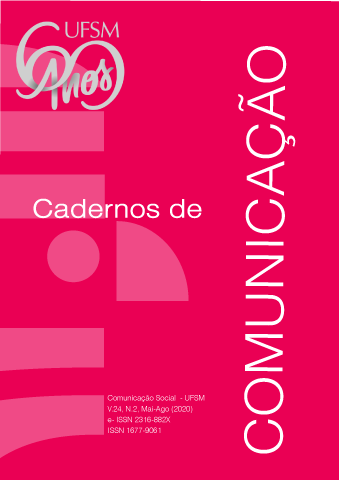Media Archeology and "excavation" on Twitter: the birth of #Rio2016 hashtag
DOI:
https://doi.org/10.5902/2316882X32828Keywords:
Media Archeology, hashtag, Twitter, #Rio2016Abstract
The media archeology is a concept that aims to understand the cultural processes through the excavation of media records. This article aims to identify how the hashtag #Rio2016 was created. Tools were used in an "archeological action" that sought digital records on websites to determine the sequence of appearance of the hashtag on Twitter. Based on media archeology concepts, the records retrieval process is presented, as well a reflection about the recovered data.
Downloads
References
COSTA-MOURA, Fernanda. Proliferação das #hashtags: lógica da ciência, discurso e movimentos sociais contemporâneos. Ágora (Rio J.), Rio de Janeiro, v. 17, n. spe, p. 141-158, Aug. 2014. Disponível em: <http://www.scielo.br/scielo.php?script=sci_arttext&pid=S1516-14982014000300012&lng=en&nrm=iso>. Acesso em: 9 Jan. 2017.
CHANG, Hsia-Ching. A New Perspective on Twitter Hashtag Use: Diffusion of Innovation Theory. In: ASIST 2010, October 22–27, 2010, Pittsburgh, PA, USA. Disponível em: <http://onlinelibrary.wiley.com/doi/10.1002/meet.14504701295/epdf>. Acesso em: 9 jan. 2017.
CHUN, Wendy Hui Kyong. The Enduring Ephemeral, or the Future Is a Memory. In: Huhtamo, E. & Parikka, J. (orgs). Media Archeology: Approaches, Applications, and Implications. Berkeley, California: University of California Press, 2011. P. 184-206.
ERNST, Wolfgang. Media Archaeography: Method and Machine versus History and Narrative of Media. In: Huhtamo, E. & Parikka, J. (orgs). Media Archeology: Approaches, Applications, and Implications. Berkeley, California: University of California Press. 2011. P. 239-255.
FRAGOSO, Sueli; RECUERO, Raquel; AMARAL, Adriana. Métodos de pesquisa para internet. Porto Alegre: Sulina, 2011.
FISCHER, Gustavo. I don´t wanna be buried in an app sematary – reflexões sobre arqueologia da mídia online entre histórias de aplicativos derrotados. In: 7º Simpósio Nacional da Associação Brasileira de Cibercultura, 2013, Curitiba. Anais eletrônicos. Curitiba: ABCiber, 2013. Disponível em: <http://www.abciber.org.br/simposio2013/anais/pdf/Eixo_8_Imaginario_Tecnologico_e_Subjetividades/26021arq70583358004.pdf>. Acesso em: 2 jan. 2017.
_______________. Desencavando Interfaces: Reflexões Sobre Arqueologia da Mídia e Procedimentos de Resgate de páginas web. In: BENEVENUTO JR, Álvaro; STEFFEN, César. (Org.). Tecnologia, pra quê? Os impactos dos dispositivos tecnológicos no campo da comunicação. 1ed.Porto Alegre: Armazém Digital, 2012, v. 1, p. 37-52.
FISCHER, Gustavo; GREBIN, Bárbara. Interfaces culturais e agir arqueológico: reflexões teórico-metodológicas para dissecar websites e softwares que operam pela Internet. In: I Colóquio Semiótica das Mídias, 2012. Anais do I Colóquio Semiótica das Mídias. vol. 1, nº 1. João Pessoa, PB: UFAL, 2012. Disponível em: < http://ciseco.org.br/anaisdocoloquio/images/csm1/CSM1_GustavoFischerBarbaraGrebin.pdf>. Acesso em: 5 jan. 2017.
HUHTAMO, Erkki. From Kaleidoscomaniac to Cybernerd: Notes Toward an Archaeology of the Media. Leonardo, vol. 30, 3/1997. Disponível em: <http://www.stanford.edu/class/history34q/readings/MediaArchaeology/HuhtamoArchae ologyOfMedia.html> Acesso em: 4 jan. 2017.
HUHTAMO, Erkki, PARIKKA, Jussi. Media Archeology: Approaches, Applications, and Implications. Berkeley: University of California Press, 2011.
JAVA, A., Song, X., Finin, T. & Tseng, B. (2007). Why we twitter: understanding microblogging usage and communities. In: Proceedings of the 9th WebKDD and 1st SNA-KDD 2007 workshop on Web mining and social network analysis (WebKDD/SNA-KDD 07), ACM, San Jose. Disponível em: < http://ebiquity.umbc.edu/_file_directory_/papers/369.pdf >. Acessado em: 09 jan. 2017
MANOVICH, Lev. The language of new media. Londres: The MIT Press, 2001.
MURTHY, Dhiraj. Twitter: social communication in the Twitter age. Cambridge: Polity Press, 2013.
RECUERO, R. Análises de redes para mídias sociais. Porto Alegre: Sulina, 2015.
TSUR, Oren; RAPPOPORT, Ari. What’s in a Hashtag? Content based Prediction of the Spread of Ideas in Microblogging Communities. In: Proceedings of the Fifth International Conference on Web Search and Web Data Mining, WSDM 2012, Seattle, WA, USA, February 8-12, 2012. Disponível em: <http://people.seas.harvard.edu/~orentsur/papers/wsdm12.pdf>. Acesso em: 09 jan. 2017.
TWITTER (2016a). Central de ajuda: como usar as hashtags. Disponível em: <https://support.twitter.com/articles/255508>. Acesso em: 9 jan. 2017.
TWITTER (2016b). Nossa empresa. Disponível em: <https://about.twitter.com/pt/company>. Acesso em: 9 jan. 2017.
TWITTER (2016c). The #Rio2016 Twitter data recap. Disponível em: <https://blog.twitter.com/official/en_us/a/2016/the-rio2016-twitter-data-recap.html>. Acesso em: 10 jan. 2017.
TWITTER (2017). The hashtag at 10 years young. Disponível em: <https://blog.twitter.com/official/en_us/topics/product/2017/the-hashtag-at-ten-years-young.html>. Acesso em: 25 ago. 2017.
ZIELINSKI, Siegfried. Arqueologia da mídia: em busca do tempo remoto das técnicas do ver e do ouvir. São Paulo: ANNABLUME, 2006.
Downloads
Published
How to Cite
Issue
Section
License
Os autores de textos aprovados pelos pareceristas de Cadernos de Comunicação cedem automaticamente e sem qualquer tipo de ônus o direito à primeira publicação do material submetido.







